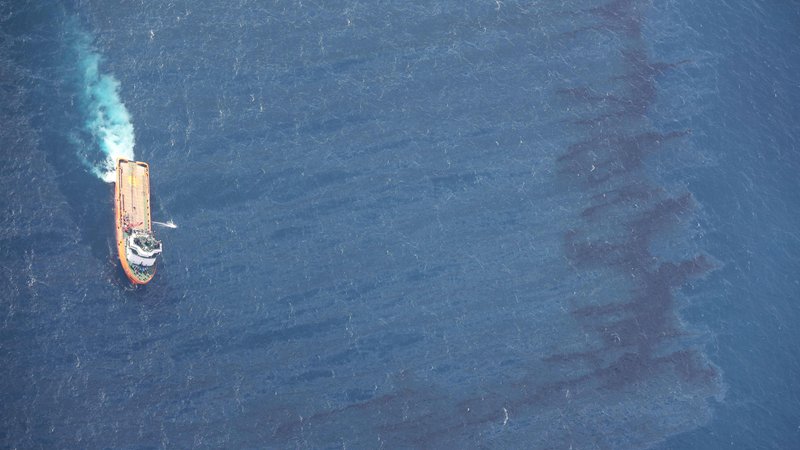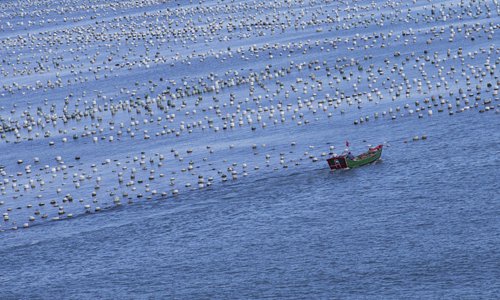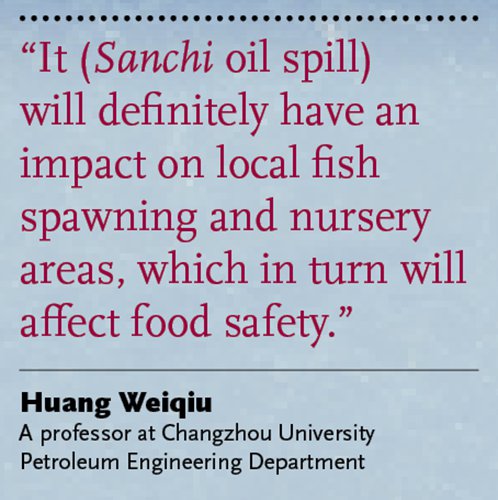○ Oil spill caused by foreign crude tanker collision in East China Sea continues to spread off the Chinese coastline
○ Serious long-term impact on local marine environment has been predicted by experts
○ China's major fishing hub is bracing for potential ecological and economic damage

This picture from the Transport Ministry of China on January 15 shows offshore supply ship De Shen working at an oil spill area off the coast of East China after the Sanchi sank. Photo: VCG
As a massive oil spill caused by the crash of Iranian tanker Sanchi earlier this month continues to spread across the East China Sea, fishermen and sea farmers in China's largest fishing hub are worried about potential ecological damage.
The fully laden crude tanker, owned and operated by the National Iranian Tanker Company (NITC), suffered a major explosion and sank eight days after its collision with Hong Kong-flagged freighter CF Crystal.
The foreign tanker was carrying condensate, an ultra-refined, highly volatile form of ultra light oil used to make products such as jet fuel. Satellite images show that the spilt oil covered 332 square kilometers of water on Sunday, The Cover reported.
In the winter, low temperatures reduce evaporation speed, leaving massive condensate floating on the surface as waves spread. Experts warn of the serious immediate and long-term impact on the marine environment.
"The oil on the surface evolves to be highly concentrated, which hinders the respiration of marine life. Oily water containing sulphide can also poison and even kill sea creatures. Without professional treatment and scientific management, its harm will soon become obvious," Huang Weiqiu, a professor at Changzhou University Petroleum Engineering Department, interpreted.
The unpredictable expansion of the massive oil slick worries many fishermen in Zhoushan, Zhejiang Province, which is China's biggest and most important fishery hub.
Sun Yun (pseudonym), who farms mussels in the sea off Zhoushan, is one of them. After the crash, he was in a panic and rightly concerned about the potential ecological and economical effects on his livelihood. He recruited people to observe if there was oil floating near his sea area and purchased heavy metal test papers to prepare for subsequent risks.
Some other local residents remained relatively calm about the potential risks, counting on pure speculation. "The sea area is vast. I guess there would not be a serious problem as long as the wind blows strongly," a resident who lives in Zhoushan city was quoted by Chinese media jiemian.com as saying.

A sea farm for mussels in Zhoushan, Zhejiang Province. Photo: VCG
Local impact
Regarding the public's concern over seafood safety, Professor Huang said, "it will definitely have an impact on local fish spawning and nursery areas, which in turn will affect food safety." Now it is imperative to calculate the size of the involved area and analyze the specific composition and concentration, he said.
He advises local fishermen to stop their activities in the area, at least temporarily. "Fisheries must make a quick assessment about the severity of pollution via visual or osphresis (smelling) inspection," he added.
On January 18, China's Ministry of Agriculture launched an investigation of the impact of the Sanchi collision on Chinese fisheries. Two investigative ships departed from Zhoushan fishing port on the same day to the wreck.
Currently, rescue teams are working against the clock to clean up oil slicks. China's State Oceanic Administration (SOA) is preparing to use professional air-sea stereoscopic equipment to continuously carry out monitoring. They are paying increased attention to protecting the valuable marine ecosystem and find solutions to safeguard local residents' health and productivity.
On January 22, SOA China Marine surveillance team #2502 and Xiangyanghong #06 and #19 patrolled and monitored the vicinity. Due to furious billows, there was no obvious oil pollution observed on the surface, Xinhua reported.
As jiemian.com reported, a local environmental group is also heading to coastal fishing villages along Zhoushan to learn more about the situation. He Li, founder of the group, told media that he is collecting more information on the dangers of pollution brought by this particular collision, in order to inform local fishermen.
"They have right to understand the impact on their future business," said He Li.
How to scientifically deal with the Sanchi oil slick and avoid a "worst-case scenario" has become a top priority for Chinese maritime authorities.
On Thursday, maritime authorities with the Chinese mainland, Iran, Panama and the Hong Kong Special Administrative Region signed an agreement to launch a joint investigation into the collision between the Sanchi and the CF Crystal, the Ministry of Transport announced.
Meanwhile, an innovative, new oil-absorbent material invented by Suzhou University has attracted the attention of the Shanghai Maritime Bureau, reported Chinese State media dyol.com.
The material, called "oil absorption treasure," was developed by Professor Lu Jianmei, vice president of Suzhou University, and her team. Its unique advantages include fast, large-volume absorption and cyclic utilization. It won second place in the National Prize for Progress in Science and Technology 2014 awards.
Soochow University Material and Chemistry Department said that relevant maritime sectors have loaded 15,000 square meters of this "oil absorption treasure" onto rescue vessels preparing to dispose the leaked condensate.
Lu told media that the concept of her research was a result of the Gulf War disaster. The war left many pipelines leaking crude oil into the sea, causing tremendous harm to sea life as well as mankind. This poignant memory impelled Lu to develop a high-efficiency oil absorption material to tackle future oil slicks.
"The magic is its innovative chemical structure," Lu said, explaining that similar products normally require four to six hours to complete a clean-up while their material takes only two to eleven seconds to "lock up oil."
Its quick reaction makes it especially suitable for large-scale emergencies like the Sanchi spill. Reportedly, this "oil absorption treasure" has been used in previous oil crises including the Dalian Xingang oil pipeline explosion and the Deepwater Horizon oil spill in 2010.

Emergency measures
As for the causes of this calamity, the contents of the Sanchi's black box containing sailing data and voice recording recovered by Chinese emergency workers on January 13 have yet to be released by authorities.
The cause is less likely to be machine failure, but rather human factors such as improper behavior of the crew and a lack of effective emergency response, said Chen Lijun, vice president of Jiangsu Maritime Vocational Institute, who has many years of experience as the chief engineer of a marine vessel, China Youth Daily reported.
He added that, when facing emergencies, staying calm while implementing basic rescue measures are essential. Crew members must make an immediate report to relevant departments for further instructions.
Huang Weiqiu warned that a tanker must be well inspected before its long-distance journey, making sure that all safety equipment is on board, in good working order and easy to reach. He stressed that the emergency alarm system must be double-checked.
"During the journey, it is necessary to ban cigarette smoking. Even shoes with nails are not allowed in order to avoid sparks on the metal floor," said Huang. "Strictly following these rules can prevent many accidents."
Who pays the bill?
Liability has yet to be confirmed, but already the massive compensation bill involving one of China's biggest fishing areas is being discussed and debated globally. Chen Lijun believes that all costs, including compensating the families of the 32 dead and missing Sanchi crew members, should be paid by NITC.
China's Supreme People's Court issued a report on January 15, titled "The provisions of several issues concerning the settlement of disputes over the compensation of marine natural resources and ecological environment."
In it, the court suggests that damaged marine ecosystems of coastal cities along the East China Sea will receive a higher level of legal protection. Due to the complex factors contributing to the pollution, claiming responsibility will be a long process, the court said, according to cyol.com.
As the Sanchi sank 160 nautical miles east of the Yangtze River estuary, experts predict that, after burning for nine days and drifting more than 100 nautical miles southward, Sanchi's trajectory may be far beyond China's 12 nautical-miles of territorial waters.
Regardless, the ecological toll and resulting compensation bill will be enormous. Legally, there should be no obstacles to claim compensation in accordance with the latest rules of the Supreme People's Court. However, due to the sensitive diplomatic affairs, experts warned that all claims should be closely coordinated by the two countries and resolved carefully, according to the China Youth Daily.
Agencies - Global Times
